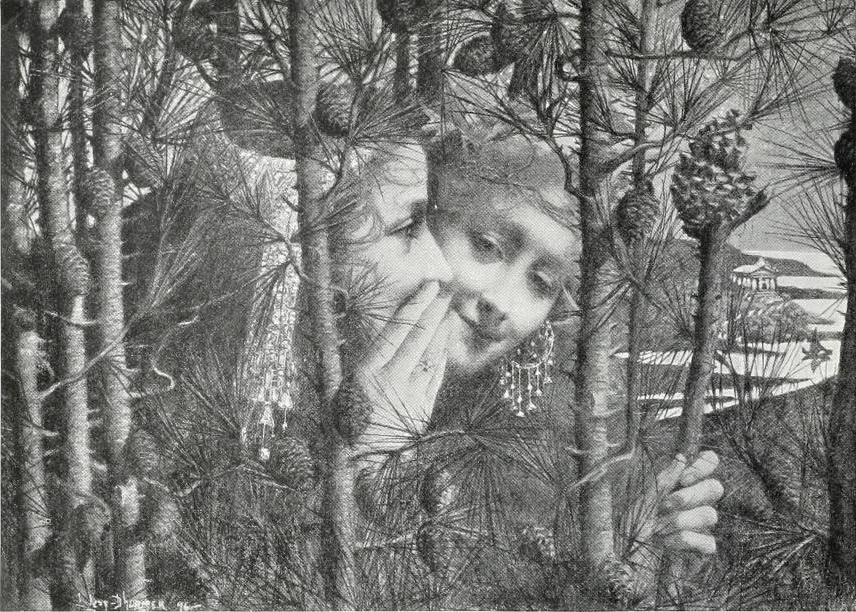William Fuller Curtis (1873-1938)
Portrait Two Women in Profile 🔴
Signed: “William Fuller Curtis”
Charcoal on Paper, 238 x 543mm
The following drawing seems to show a familiarity with the works of Lucien Lévy-Dhurmer, whose haunting portrayals of women in profile were often set against a background of trees and foliage. It also brings to mind the drawings of Simeon Solomon, whose tortured creations were passing from the high-finish of the pre-Raphaelites to the blurred outlines of the symbolists.
William Fuller Curtis was born in Staten Island in 1873 to an interesting family. He was the nephew of George William Curtis (1824-1892), abolitionist and cofounder of the Republican Party. Another uncle, the surgeon Edward Curtis (1838-1912), who he later lived with, performed an autopsy on the body of Abraham Lincoln, after his assassination in 1865.
Little is known of his artistic upbringing, though by the age of 17 he was in Paris, studying at the Académie Julian with his sister Jane Bridgham Curtis Child (1868-1958).
An early teacher was the American Julius Rolshoven (1858-1930), the contradictory figure, that spent some of his life refurbishing his Florentine castle and another painting the Pueblo Indians in New Mexico. Jules-Joseph Lefebvre (1836-1911) and Tony Robert Fleury (1837-1911), sophisticated technicians and influential teachers, seem to have left an impression and it is telling that in his final term at the Academie Julian, Curtis won first prize in drawing.
Before returning home in 1893, he travelled in northern Italy. His later drawings are indebted to renaissance masters, others are informed by medieval saints, Arthurian myth and legend.
Such influences may explain his dealings with the art critic Charles Eliot Norton, who sat for him in 1903. Norton, then nearing the end of his life, had been an early follower of John Ruskin and was on friendly terms with Edward Burne-Jones. He was also largely behind the small ripples of pre-Raphaelitism flowing back across the Atlantic.
Though highly influential in Britain, such pictures were unsuited to a young, practical country, less inclined to idealise the medieval past of another continent.
Such forces might explain William Fuller Curtis’ decision to give himself to the eccentric craft of drawing with a burning pencil after his return to America in 1893. The medium is less forgiving than drawing in pencil, which might explain Curtis’ small and scattered output. Nevertheless such works did sell and he could count the industrialists George Westinghouse and Robert Dix Benson among the buyers.
An article by the art critic Leila Mechlin in 1903, describes how:
he draws… with great clearness and accuracy on the surface of the white wooden panel; then certain parts are carved, and the surroundings cut away... Finally the whole is modelled and shaded by the burning pencil.
…every detail is shown… the outlines are direct and unequivocal and the shadows picturesque and significant. This work [underdrawing] is seemingly lost in the application of the burning pencil, just as the drawing on the canvas is obliterated by the paint…
The faces of the angel and the maiden are chaste and soulful; the lines of the composition are long, sweeping and graceful. It is carved and burnt and the color is rich, many toned and strong. The trees and foliage occupying the terminal spaces are dark red-brown, whereas the distant fields which form the background take on the tone and quality of gold.
Nevertheless, such articles were few and far between and much as etchings give little indication of the laborious efforts behind them, these works were later assumed to be mass produced, or dismissed as sophisticated examples of folk art.
“William Fuller Curtis”
Detail from Untitled Frieze, undated - WIlliam Fuller Curtis
Pyrography and watercolor on wood panel,
Library of the Ashfield Historical Society
Ashfield, Massachusetts, U.S.A.
Detail from Untitled Frieze, 1904 - William Fuller Curtis (Kaminski Auctions, Massachusetts)
Fêtes de Cérès " by Lucien Lévy-Dhurmer (1865-1953)
University of Toronto (Internet Archive) Studio Magazine 1897



